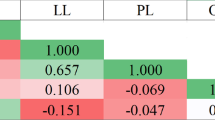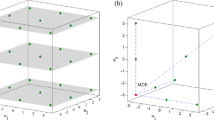Abstract
The failure criteria of practical soil mass are very complex, and have significant influence on the safety factor of slope stability. The Coulomb strength criterion and the power-law failure criterion are classically simplified. Each one has limited applicability owing to the noticeable difference between calculated predictions and actual results in some cases. In the work reported here, an analysis method based on the least square support vector machine (LSSVM), a machine learning model, is purposefully provided to establish a complex nonlinear failure criterion via iteration computation based on strength test data of the soil, which is of more extensive applicability to many problems of slope stability. In particular, three evaluation indexes including coefficient of determination, mean absolute percentage error, and mean square error indicate that fitting precision of the machine learning-based failure criterion is better than those of the linear Coulomb criterion and nonlinear power-law criterion. Based on the proposed LSSVM approach to determine the failure criterion, the limit equilibrium method can be used to calculate the safety factor of three-dimensional slope stability. Analysis of results of the safety factor of two three-dimensional homogeneous slopes shows that the maximum relative errors between the proposed approach and the linear failure criterion-based method and the power-law failure criterion-based method are about 12% and 7%, respectively.
Similar content being viewed by others
References
Collins I F, Gunn C I M, Pender M J, Yan W. Slope stability analyses for materials with a non-linear failure envelope. International Journal for Numerical and Analytical Methods in Geomechanics, 1988, 12(5): 533–550
Kang F, Li J J. Artificial bee colony algorithm optimized support vector regression for system reliability analysis of slopes. Journal of Computing in Civil Engineering, 2016, 30(3): 04015040
Chen W F, Scawthorn C R. Limit analysis and limit equilibrium solutions in soil mechanics. Soil and Foundation, 1970, 10(3): 13–49
Sun D A, Wang L, Li L. Stability of unsaturated soil slopes with cracks under steady-infiltration conditions. International Journal of Geomechanics, 2019, 19(6): 04019044
Wang L, Sun D A, Yao Y, Tan Y. Seismic stability of 3D piled unsaturated earth slopes using kinematic limit analysis. Soil Dynamics and Earthquake Engineering, 2019, 126: 105821
Lian J, Wu J. Surficial stability analysis of soil slope under seepage based on a novel failure mode. Frontiers of Structural and Civil Engineering, 2021, 15(3): 712–726
Sheng K, Hong B N, Liu X, Shan H. Modified Bishop method for stability analysis of weakly sloped subgrade under centrifuge model test. Frontiers of Structural and Civil Engineering, 2021, 15(3): 727–741
Matsui T, San K C. Finite element slope stability analysis by shear strength reduction technique. Soil and Foundation, 1992, 32(1): 59–70
Yuan W, Li J X, Li Z H, Wang W, Sun X Y. A strength reduction method based on the Generalized Hoek-Brown (GHB) criterion for rock slope stability analysis. Computers and Geotechnics, 2020, 117: 103240
Fellenius W. Calculation of the stability of earth dams. In: Transactions of The 2nd Congress on Large Dams, International Commission on Large Damsof The World Power Conference. 1936, 4: 445–462
Bishop A W. The use of the slip circle in the stability analysis of earth slopes. Geotechnique, 1955, 5(1): 7–17
Janbu N. Slope Stability Computations. Hoboken: John Wiley, 1973
Morgenstern N R, Price V E. The analysis of the stability of general slip surfaces. Geotechnique, 1965, 15(1): 79–93
Spencer E. A method of analysis for stability of embankments using parallel inter-slice forces. Geotechnique, 1967, 17(1): 11–26
Bell J M. General slope stability analysis. Journal of the Soil Mechanics and Foundations Division, 1968, 94(6): 1253–1270
Zhu D Y, Lee C F. Explicit limit equilibrium solution for slope stability. International Journal for Numerical and Analytical Methods in Geomechanics, 2002, 26(15): 1573–1590
Zheng H, Tham L G. Improved Bell’s method for the stability analysis of slopes. International Journal for Numerical and Analytical Methods in Geomechanics, 2009, 33(14): 1673–1689
Rabczuk T, Belytschko T. Cracking particles: A simplified meshfree method for arbitrary evolving cracks. International Journal for Numerical Methods in Engineering, 2004, 61(13): 2316–2343
Rabczuk T, Belytschko T. A three-dimensional large deformation meshfree method for arbitrary evolving cracks. Computer Methods in Applied Mechanics and Engineering, 2007, 196(29–30): 2777–2799
Rabczuk T, Zi G, Bordas S, Nguyen-Xuan H. A simple and robust three-dimensional cracking-particle method without enrichment. Computer Methods in Applied Mechanics and Engineering, 2010, 199(37–40): 2437–2455
Ren H, Zhuang X, Cai Y, Rabczuk T. Dual-horizon peridynamics. International Journal for Numerical Methods in Engineering, 2016, 108(12): 1451–1476
Ren H, Zhuang X, Rabczuk T. Dual-horizon peridynamics: A stable solution to varying horizons. Computer Methods in Applied Mechanics and Engineering, 2017, 318: 762–782
Areias P, Msekh M A, Rabczuk T. Damage and fracture algorithm using the screened Poisson equation and local remeshing. Engineering Fracture Mechanics, 2016, 158: 116–143
Areias P, Reinoso J, Camanho P P, César de Sá J, Rabczuk T. Effective 2D and 3D crack propagation with local mesh refinement and the screened Poisson equation. Engineering Fracture Mechanics, 2018, 189: 339–360
Hedayat A A, Ahmadi Afzadi E, Kalantaripour H, Morshedi E, Iranpour A. A new predictive model for the minimum strength requirement of steel moment frames using artificial neural network. Soil Dynamics and Earthquake Engineering, 2019, 116: 69–81
Rivera J I, Bonilla C A. Predicting soil aggregate stability using readily available soil properties and machine learning techniques. Catena, 2020, 187: 104408
Oommen T, Baise L G, Vogel R. Validation and application of empirical liquefaction models. Journal of Geotechnical and Geoenvironmental Engineering, 2010, 136(12): 1618–1633
Bikmukhametov T, Jäschke J. Combining machine learning and process engineering physics towards enhanced accuracy and explainability of data-driven models. Computers & Chemical Engineering, 2020, 138: 106834
Merghadi A, Yunus A P, Dou J, Whiteley J, ThaiPham B, Bui D T, Avtar R, Abderrahmane B. Machine learning methods for landslide susceptibility studies: A comparative overview of algorithm performance. Earth-Science Reviews, 2020, 207: 103225
Smiti A. When machine learning meets medical world: Current status and future challenges. Computer Science Review, 2020, 37: 100280
Sheil B B, Suryasentana S K, Cheng W C. Assessment of anomaly detection methods applied to microtunneling. Journal of Geotechnical and Geoenvironmental Engineering, 2020, 146(9): 04020094
Zhang N, Shen S L, Zhou A, Jin Y F. Application of LSTM approach for modelling stress-strain behaviour of soil. Applied Soft Computing, 2021, 100: 106959
Samui P. Slope stability analysis: A support vector machine approach. Environmental Geology (Berlin), 2008, 56(2): 255–267
Garg A, Garg A, Tai K, Sreedeep S. An integrated SRM-multi-gene genetic programming approach for prediction of factor of safety of 3-D soil nailed slopes. Engineering Applications of Artificial Intelligence, 2014, 30: 30–40
Koopialipoor M, Jahed Armaghani D, Hedayat A, Marto A, Gordan B. Applying various hybrid intelligent systems to evaluate and predict slope stability under static and dynamic conditions. Soft Computing, 2019, 23(14): 5913–5929
Ferentinou M, Fakir M. Integrating Rock Engineering Systems device and artificial neural networks to predict stability conditions in an open pit. Engineering Geology, 2018, 246: 293–309
Zhou J, Li E, Yang S, Wang M, Shi X, Yao S, Mitri H S. Slope stability prediction for circular mode failure using gradient boosting machine approach based on an updated database of case histories. Safety Science, 2019, 118: 505–518
Huang F M, Cao Z, Guo J, Jiang S H, Li S, Guo Z Z. Comparisons of heuristic, general statistical and machine learning models for landslide susceptibility prediction and mapping. Catena, 2020, 191: 104580
Wang Y K, Huang J S, Tang H M, Zeng C. Bayesian back analysis of landslides considering slip surface uncertainty. Landslides, 2020, 17(9): 2125–2136
Wei X, Zhang L L, Yang H Q, Zhang L M, Yao Y P. Machine learning for pore-water pressure time-series prediction: Application of recurrent neural networks. Geoscience Frontiers, 2021, 12(1): 453–467
Safa M, Sari P A, Shariati M, Suhatril M, Trung N T, Wakil K, Khorami M. Development of neuro-fuzzy and neuro-bee predictive models for prediction of the safety factor of eco-protection slopes. Physica A: Statistical Mechanics and its Applications, 2020, 550: 124046
Suykens J A K, Vandewalle J. Least squares support vector machine classifiers. Neural Processing Letters, 1999, 9(3): 293–300
Suykens J A K, Gestel T V, Brabanter J D, Moor B D, Vandewalle J. Least Squares Support Vector Machines. Singapore: World Scientific, 2002
Duncan J M. State of the art: Limit equilibrium and finite-element analysis of slopes. Journal of Geotechnical Engineering, 1996, 122(7): 577–596
Li S G. A reflection on the Mohr failure criterion. Mechanics of Materials, 2020, 148: 103442
Johnston I W. Strength of intact geomechanical materials. Journal of Geotechnical Engineering, 1985, 111(6): 730–749
Zhang X J, Chen W F. Stability analysis of slopes with general nonlinear failure criterion. International Journal for Numerical and Analytical Methods in Geomechanics, 1987, 11(1): 33–50
Drescher A, Christopoulos C. Limit analysis slope stability with nonlinear yield condition. International Journal for Numerical and Analytical Methods in Geomechanics, 1988, 12(3): 341–345
Jiang J C, Baker R, Yamagami T. The effect of strength envelope nonlinearity on slope stability computations. Canadian Geotechnical Journal, 2003, 40(2): 308–325
Yang X L, Yin J H. Slope stability analysis with nonlinear failure criterion. Journal of Engineering Mechanics, 2004, 130(3): 267–273
Rafiai H, Jafari A, Mahmoudi A. Application of ANN-based failure criteria to rocks under polyaxial stress conditions. International Journal of Rock Mechanics and Mining Sciences, 2013, 59: 42–49
Wu S, Zhang S, Guo C, Xiong L. A generalized nonlinear failure criterion for frictional materials. Acta Geotechnica, 2017, 12(6): 1353–1371
Xue X H, Xiao M. Deformation evaluation on surrounding rocks of underground caverns based on PSO-LSSVM. Tunnelling and Underground Space Technology, 2017, 69: 171–181
Barzegar R, Ghasri M, Qi Z, Quilty J, Adamowski J. Using bootstrap ELM and LSSVM models to estimate river ice thickness in the mackenzie river basin in the northwest territories, Canada. Journal of Hydrology (Amsterdam), 2019, 577: 123903
Adnan R M, Liang Z, Heddam S, Zounemat-Kermani M, Kisi O, Li B. Least square support vector machine and multivariate adaptive regression splines for streamflow prediction in mountainous basin using hydro-meteorological data as inputs. Journal of Hydrology (Amsterdam), 2020, 586: 124371
Wei J, Chen H. Determining the number of factors in approximate factor models by twice K-fold cross validation. Economics Letters, 2020, 191: 109149
Chandler R J. Lias clay: The long-term stability of cutting slopes. Geotechnique, 1974, 24(1): 21–38
MATLAB. Version 9.4.0. Natick, MA: The Mathworks, Inc., 2018
Perry J. A technique for defining non-linear shear strength envelopes, and their incorporation in a slope stability method of analysis. Quarterly Journal of Engineering Geology and Hydrogeology, 1994, 27(3): 231–241
Tordesillas A, Zhou Z Z, Batterham R. A data-driven complex systems approach to early prediction of landslides. Mechanics Research Communications, 2018, 92: 137–141
Zhou X P, Huang X C, Zhao X F. Optimization of the critical slip surface of three-dimensional slope by using an improved genetic algorithm. International Journal of Geomechanics, 2020, 20(8): 04020120
Xiao S G, Guo W D, Zeng J X. Factor of safety of slope stability from deformation energy. Canadian Geotechnical Journal, 2018, 55(2): 296–302
Vapnik V N. Statistical Learning Theory. New York: Wiley-Interscience, 1998
Brabanter K D, Karsmakers P, Ojeda F, Alzate C, Brabanter J D, Pelckmans K, Moor B D, Vandewalle J, Suykens J A K. LS-SVMlab Toolbox User’s Guide. Heverlee: Katholieke Universiteit Leuven, 2010
Acknowledgements
This research was supported by the National Natural Science Foundation of China (Grant No. 51578466).
Author information
Authors and Affiliations
Corresponding author
Rights and permissions
About this article
Cite this article
Xiao, S., Li, S. LSSVM-based approach for refining soil failure criteria and calculating safety factor of slopes. Front. Struct. Civ. Eng. 16, 871–881 (2022). https://doi.org/10.1007/s11709-022-0863-8
Received:
Accepted:
Published:
Issue Date:
DOI: https://doi.org/10.1007/s11709-022-0863-8




